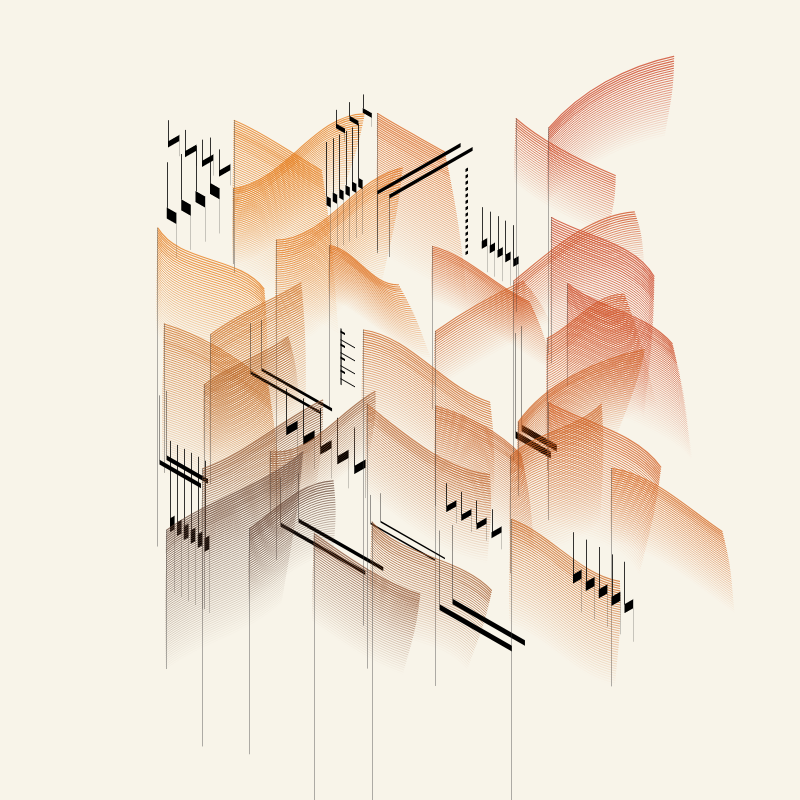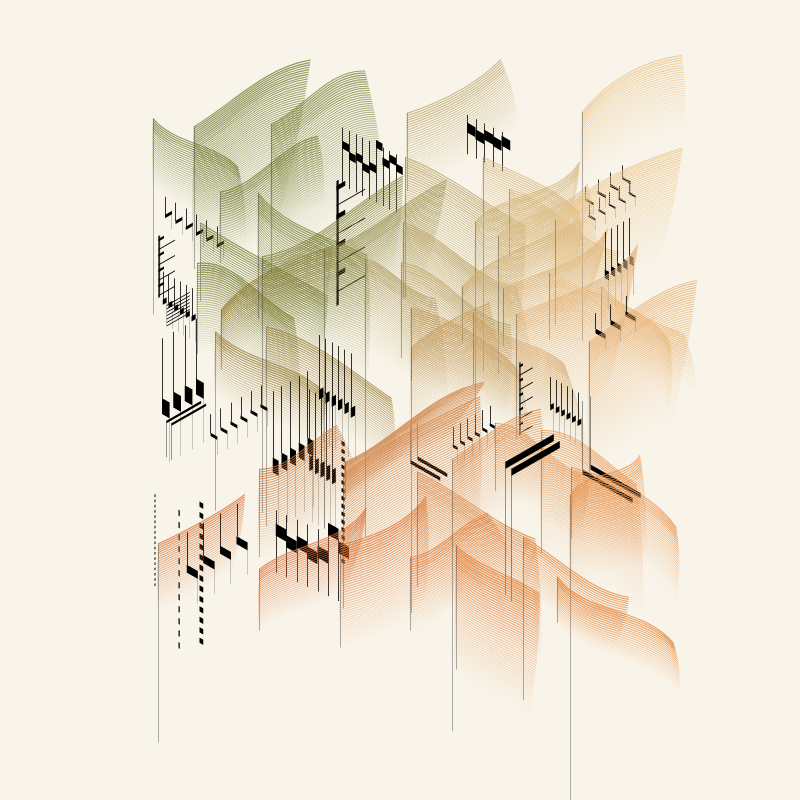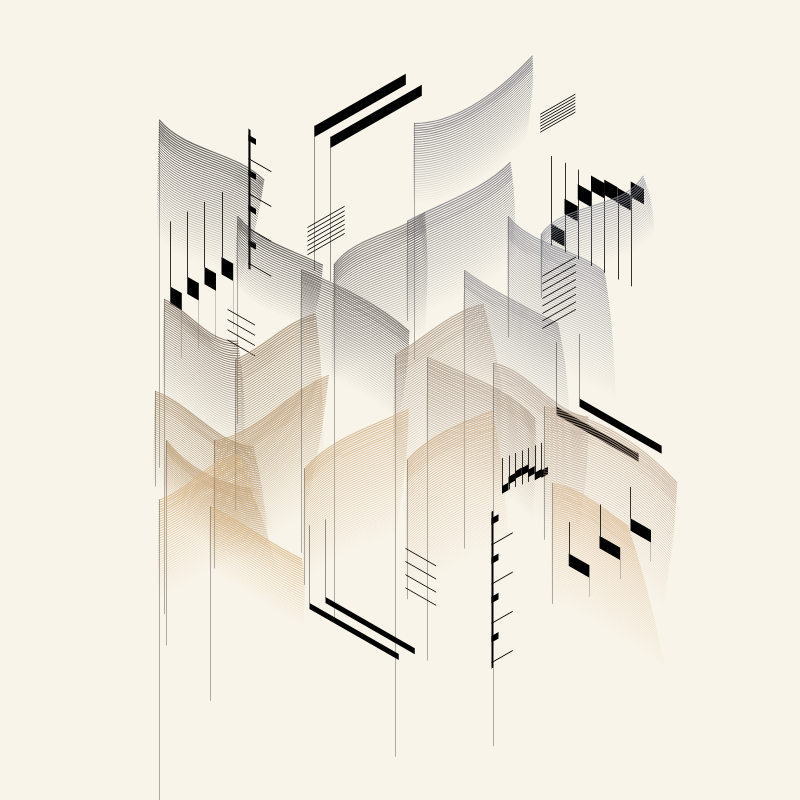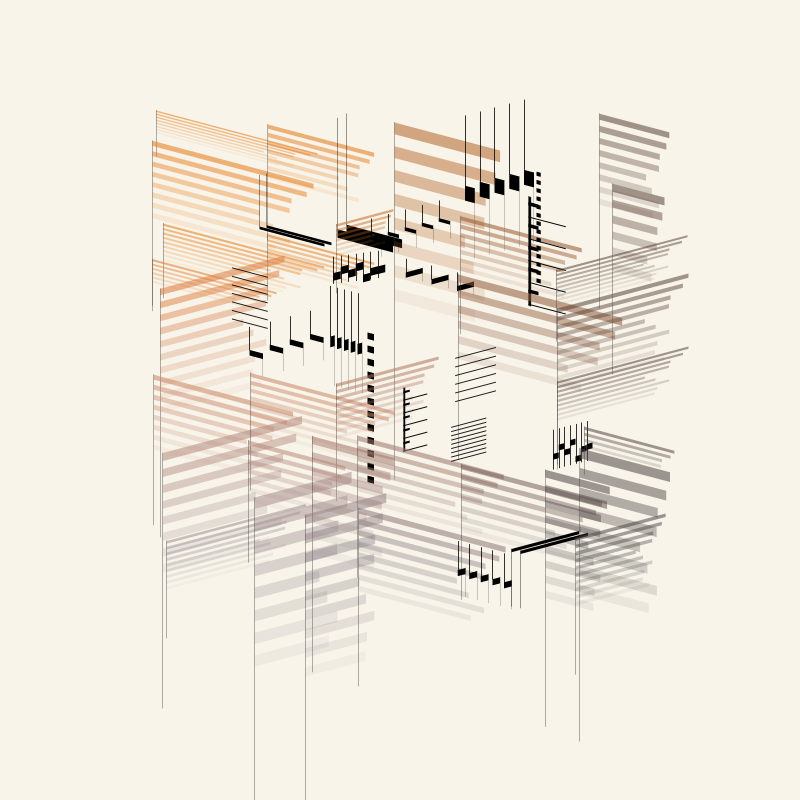by Aleksandra
Code Weaveresses
IPFS

30 November 2022•TEZOS•IPFS
The initial spark for this piece started with Armin Hofmann’s exercises in style and composition. Just as George Nelson wrote in the preface to Armin’s book Graphic Design Manual: Principles and Practices: "Despite all our efforts to simplify things - efforts constantly expanding in order to keep abreast of steadily increasing complexity - nothing is very simple anymore", these explorations just opened doors to other issues, and further grounded the idea that "if problems can be correctly stated, they can be solved."
Armin suggests we go back to the beginning, to concern ourselves with dots and circles and lines and then bring opposed components in confrontation. "Confrontation is a theme on which variations can be played with any desired consonances, with any imaginable values, and in a great variety of ways. [...] (Only then) (s)he will be able to find creative solutions to the problems presented by the confrontation of opposites."
Very quickly opposed components, even with extending the angle of vision from the two-dimensional surface to the three-dimensional space, and with the contrasts of thin-thick, solid-transparent, softened-hardened line, etc., started looking like I’m weaving complicated plots, visually similar to textile works by Bauhaus women - Gunta Stölzl, Anni Albers, Gertrud Preiswerk and others.
When Gropius founded the Bauhaus school in 1919, he proclaimed that “every eligible person whose talent and training are considered adequate will be accepted without regard to age and sex.” However, in practice, discriminatory gender roles were reinforced, and female students were guided and advised to work with textiles rather than in workshops for heavy crafts such as carpentry. Despite that, Gropius’s “women’s section” became one of its most collaborative and brave experimental sectors.
A hundred years later, it is disappointing to see we still carry on with inherited gender roles. Check the number of female computer science students in your country. How are things going "at the intersection of arts and technology"? I've implemented some of the percentages from Serbia in the distribution of shapes in the final compositions. I sampled the number of female vs. male students at the Faculty of Mathematics and the University of Arts (where I studied and now work), and gender distribution among graduated students, and it didn't look bad at all. But then I realized I'm the only female professor (out of 5) teaching main subjects at doctoral studies program in digital arts.
"When a group is underrepresented, people come to take that underrepresentation as the norm." Since representation is imperative to achieving equality, it is equally critical to change the biases we’ve developed over centuries.
For the title, I chose a dated version of the word for a female weaver on purpose. My native language is one of the Slavic languages, which are all gender sensitive. It is natural to have feminitives, but since historically some occupations were less (or not at all) practiced by women, many of the feminitives for those professions, jobs, and specializations are rarely used or don't exist in the dictionary. Also, not surprisingly, the dominant version of the noun describing a person who weaves in Serbian would be the female noun "tkalja", whereas the male version is so rare that is missing from some dictionaries. Conscientiously choosing the female version of the noun for the title, I position myself and this piece in the historical context with Bauhaus weveresses, contemporary language, and gender contexts, and finally in the curatorial context of the exhibition.
Code Weaveresses is part of the FEMGEN exhibition curated by Micol Ap @verticalcrypoto in partnership with @RtClick_Save and @artblocks_io.
Armin suggests we go back to the beginning, to concern ourselves with dots and circles and lines and then bring opposed components in confrontation. "Confrontation is a theme on which variations can be played with any desired consonances, with any imaginable values, and in a great variety of ways. [...] (Only then) (s)he will be able to find creative solutions to the problems presented by the confrontation of opposites."
Very quickly opposed components, even with extending the angle of vision from the two-dimensional surface to the three-dimensional space, and with the contrasts of thin-thick, solid-transparent, softened-hardened line, etc., started looking like I’m weaving complicated plots, visually similar to textile works by Bauhaus women - Gunta Stölzl, Anni Albers, Gertrud Preiswerk and others.
When Gropius founded the Bauhaus school in 1919, he proclaimed that “every eligible person whose talent and training are considered adequate will be accepted without regard to age and sex.” However, in practice, discriminatory gender roles were reinforced, and female students were guided and advised to work with textiles rather than in workshops for heavy crafts such as carpentry. Despite that, Gropius’s “women’s section” became one of its most collaborative and brave experimental sectors.
A hundred years later, it is disappointing to see we still carry on with inherited gender roles. Check the number of female computer science students in your country. How are things going "at the intersection of arts and technology"? I've implemented some of the percentages from Serbia in the distribution of shapes in the final compositions. I sampled the number of female vs. male students at the Faculty of Mathematics and the University of Arts (where I studied and now work), and gender distribution among graduated students, and it didn't look bad at all. But then I realized I'm the only female professor (out of 5) teaching main subjects at doctoral studies program in digital arts.
"When a group is underrepresented, people come to take that underrepresentation as the norm." Since representation is imperative to achieving equality, it is equally critical to change the biases we’ve developed over centuries.
For the title, I chose a dated version of the word for a female weaver on purpose. My native language is one of the Slavic languages, which are all gender sensitive. It is natural to have feminitives, but since historically some occupations were less (or not at all) practiced by women, many of the feminitives for those professions, jobs, and specializations are rarely used or don't exist in the dictionary. Also, not surprisingly, the dominant version of the noun describing a person who weaves in Serbian would be the female noun "tkalja", whereas the male version is so rare that is missing from some dictionaries. Conscientiously choosing the female version of the noun for the title, I position myself and this piece in the historical context with Bauhaus weveresses, contemporary language, and gender contexts, and finally in the curatorial context of the exhibition.
Code Weaveresses is part of the FEMGEN exhibition curated by Micol Ap @verticalcrypoto in partnership with @RtClick_Save and @artblocks_io.
Artist and programmer.
instagram.com/aleksandrajovanic/
twitter.com/alexis_o_O
64 EDITIONS
•0 RESERVES
minted
64 / 64
fixed price
10 TEZ
Lorem ipsum project longer longer
0.00001 ETH
Lorem ipsum project longer longer
0.00001 ETH
Lorem ipsum project longer longer
0.00001 ETH
Lorem ipsum project longer longer
0.00001 ETH
Lorem ipsum project longer longer
0.00001 ETH
Lorem ipsum project longer longer
0.00001 ETH
Lorem ipsum project longer longer
0.00001 ETH
Lorem ipsum project longer longer
0.00001 ETH
Lorem ipsum project longer longer
0.00001 ETH
Lorem ipsum project longer longer
0.00001 ETH
Lorem ipsum project longer longer
0.00001 ETH
Lorem ipsum project longer longer
0.00001 ETH
Lorem ipsum project longer longer
0.00001 ETH
Lorem ipsum project longer longer
0.00001 ETH
Lorem ipsum project longer longer
0.00001 ETH
Lorem ipsum project longer longer
0.00001 ETH
Lorem ipsum project longer longer
0.00001 ETH
Lorem ipsum project longer longer
0.00001 ETH
Lorem ipsum project longer longer
0.00001 ETH
Lorem ipsum project longer longer
0.00001 ETH
Lorem ipsum project longer longer
0.00001 ETH
Lorem ipsum project longer longer
0.00001 ETH
Lorem ipsum project longer longer
0.00001 ETH
Lorem ipsum project longer longer
0.00001 ETH























